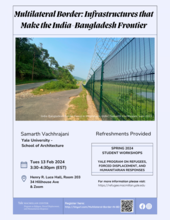If you look at a map of the India-Bangladesh border, it will appear as a set of continuous lines, stretching across the monumental Brahmaputra River, the Khasi, Garo, and Jaintia Hills of Meghalaya, and the plains of Assam and Bengal. First marked in 1947 - during the partition of the Indian Subcontinent, over the years, simmering concerns of ethnic self-determination movements, the Bangladesh Liberation War of 1971, and insecure territorial control invented the urgency of marking the border spatially. It is symptomatic of a global clamor for walls and fences that compel us to think in binary terms and promise airtight national sovereignties. However, on the ground, between the seams of global exchanges, border fences and walls are becoming multi-talented objects that are fading sovereignties for capital to move. The illusion of a complete borderline on a map, flattening the political and topographical realities, can warrant expanding state-controlled apparatuses into routines of daily life along the edges of the two nations.
Therefore, by paying attention to apparatuses like the Integrated Border Checkposts, limestone mining and cement factories, and a conveyor belt that moves stones between India and Bangladesh, Samarth Vachhrajani illustrates how a multilateral border is under construction that undermines the logic of a continuous borderline. Through the India-Bangladesh border, he documents how erosion of sovereignty is made possible by the border apparatuses, like fences or checkposts, originally intended for capture and control of mobilities, have themselves doubled as agents for exploitative global connections.
Samarth Vachhrajani is a Master of Environmental Design (M.E.D) student at Yale School of Architecture (YSOA). Before coming to Yale, he finished his undergraduate studies in architecture at Iowa State University. His research interests broadly involve questioning how architecture is co-opted for authorizing violence under Hindu Nationalist Governance in India. Moreover, he is interested in understanding how spatial and architectural knowledge is mobilized in the logics of legislation and governance. His M.E.D. thesis titled ‘Authorizing Violence: Spatial Languages of Citizenship Politics in Northeast India.’ assembles detention centers, border fences, national parks, and demolition episodes as spatial variables that materialize ethno-nationalism in Northeast India. He has participated in a research residency at the Canadian Center for Architecture titled ‘How To: Do No Harm’ and was recognized by the Avery Review in their 2021 Essay Prize. He has published and edited with Pidgin (Forthcoming), Paprika! (YSOA), Bnieuws (TU Delft) and Datum (Iowa State University). Samarth has also organized and participated in panels at YSOA (with MED Working Group) and the Venice Architecture Biennale (2021). He has also been invited to present his work at the Society of Architectural Historians (North-East chapter) and recently at the Symposium for Urban Design Theory and History at TU Delft.

